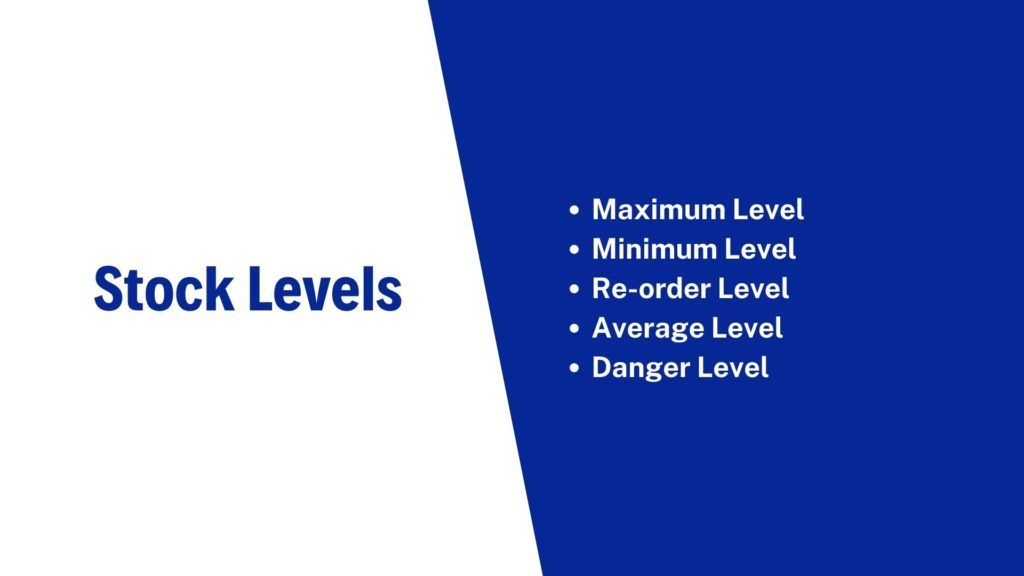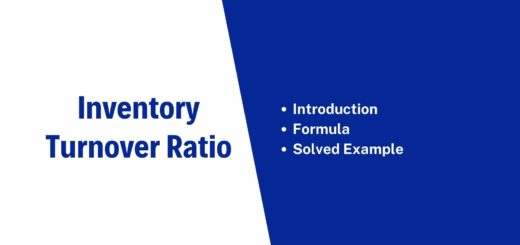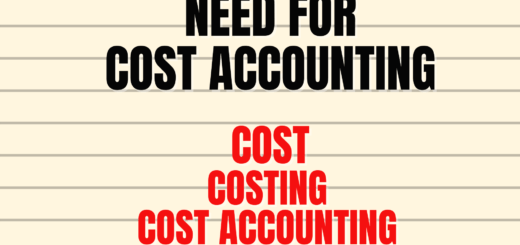Stock Levels (Maximum, Minimum, Re-order, Average and Danger Level) | Free Articles
Table of Contents
Stock Levels
What are the stock levels?
Stock level refers to the amount of goods or raw materials that should be maintained by businesses to continue their activities and avoid any situations like understocking or overstocking. Every organization should always keep an optimum amount of inventory to ensure the regular operation of its production activities.
Inventory acts as a bridge between production and sales of business and ensures a regular supply of finished goods to customers. Raw materials, work-in-progress, finished goods, and various consumables like fuel and stationery are three important types of inventories that every firm needs to maintain.
Inventory managers should properly control the inventory and determine the optimum size to be always kept within the organization. Managers should consider various factors like storage space of firm, the frequency with which inventory is sold or used, risk of inventory getting outdated before it is used, insurance cost on inventory, etc. for deciding the right amount of stock. Major types of stock levels of inventory are as follows:
1. Maximum Level
It is the quantity of material beyond which a firm should not exceed its stocks. If the quantity exceeds the maximum level limit then it will be termed as overstocking. A firm avoids overstocking because it will result in high material costs. Overstocking will lead to the requirement of more capital, more space for storing the materials, and more charges of losses from obsolescence.
This level of stock indicates the maximum figure of inventory quantity held in stock at any time. The quantity of stock should not exceed the level.
The following factors should be considered while fixing the maximum level of various stocks.
- Re-order level:- The product of maximum consumption of inventory item and its maximum delivery period.
- Minimum Consumption: The minimum consumption and delivery period for each stock should be known.
- Adequacy of working capital:- It should be known to maintained at a maximum inventory level.
- Storage space:- It should be stored properly in stores.
- Additional storage cost: The cost required for additional storage should be considered. Additional insurance costs should be considered.
- Regular supply:- In the case of important materials due to their irregular supply, the maximum level should be high.
Maximum Stock Level Formula:
Maximum Stock Level = Reordering Level + Reordering Quantity – (Minimum Consumption x Minimum Reordering period)

2. Minimum Level
This represents the quantity that must be maintained in hand at all times. If stocks are less than the minimum level, then the work will stop due to a shortage of materials.
The minimum level shows the lowest figure of inventory balance, which must be maintained in hand at all times so that there is no stoppage of production due to non-availability of inventory. This level is possible to maintain a fixed level after taking into consideration the rate of consumption and the time required to acquire sufficient material to avoid dislocation of production.
The following factors should be considered while fixing the minimum level of various stocks.
- Re-order level:- The product of maximum consumption of inventory item and its maximum delivery period.
- Average rate of consumption:- Average rate of consumption for each inventory items.
- Maximum consumption and maximum delivery period:- in respect of each item to determine its re-order level.
- Average re-order Period:- to each item. This period can be calculated by averaging minimum and maximum period.
Minimum Stock Level Formula:
Minimum stock Level = Re-ordering Level – (Normal/Average Consumption x Normal/Average Reorder Period)
3. Reorder Level
When the quantity of materials reaches a certain level then fresh order is sent to procure materials again. The order is sent before the materials reach the minimum stock level.
The reordering level is fixed between the minimum level and the maximum level. The rate of consumption, the number of days required to replenish the stocks, and the maximum quantity of materials required on any day are taken into consideration while fixing the reordering level.
The following factors are considered white maintain this re-order level.
- Maximum consumption
- Maximum Re-order period
- Minimum level
Re-order Level Formula:
Reordering Level = Maximum Consumption Rate x Maximum Reorder period.
OR
=Minimum level + (Normal/Average Consumption x Normal/Average Reorder Period)
4. Average Stock Levels
It is the level of an average of minimum level and Maximum level. It means the average level is maintained in states.
Average level Formula:
Average stock level = (Maximumlevel+Minimumlevel)/2
5. Danger Stock Levels
This is the level below the minimum stock level. When a stock reaches this level, immediate action is needed to replace the replacement of stock. If the stock is reached at this level, the normal lead time is not available, and hence regular purchase procedure can not be adopted. This may result in high-cost remedial action only. If this is fixed below the re-order level and above the minimum level, it will be possible to take preventive action.
Danger level Formula:
Danger level = (Average rate of consumption)×Urgent supply time
Solved Example
Calculate minimum stock level, maximum stock level, and re-ordering level:
(i) Maximum Consumption = 300 units per day
(ii) Minimum Consumption = 180 units per day
(ii) Normal Consumption =190 units per day
(iv) Reorder period = 10-15 days
(v) Reorder quantity = 2,000 units
(vi) Normal reorder period = 13 days.
Solution:
1. Reordering Level = Maximum Consumption x Maximum Reorder period
= 300 units X 15 = 4,500 units
2. Minimum Stock Value = Reordering Level – (Normal Consumption x Normal Reordering Period)
= 4,500 – (190 X 13) = 4,500 – 2,470 = 2,030 units
3. Maximum Stock Level = Reordering Level + Reorder Quantity – (Minimum Consumption x Minimum Reorder period)
= 4,500 + 2,000 – (180 X 10) = 4,500 + 2,000 – 1,800 = 4700 units.
Articles related to Cost Accounting



It is very good
yes you are right!!
The article is very helpful
I recomend